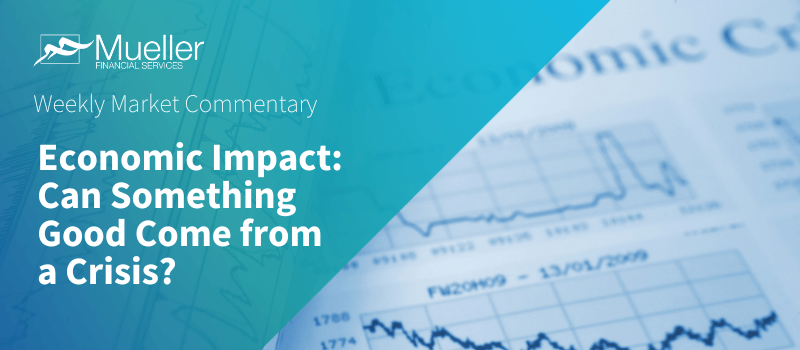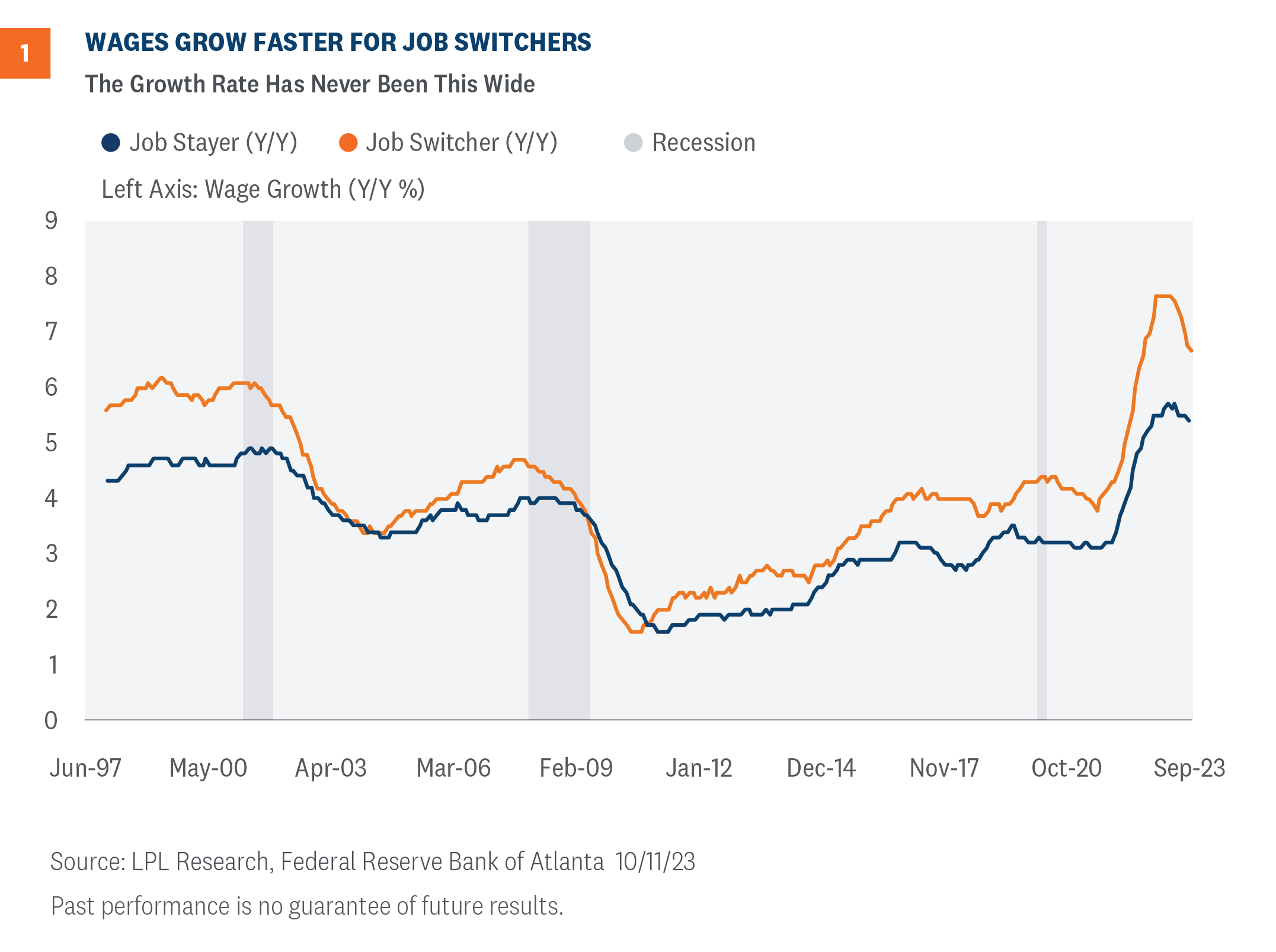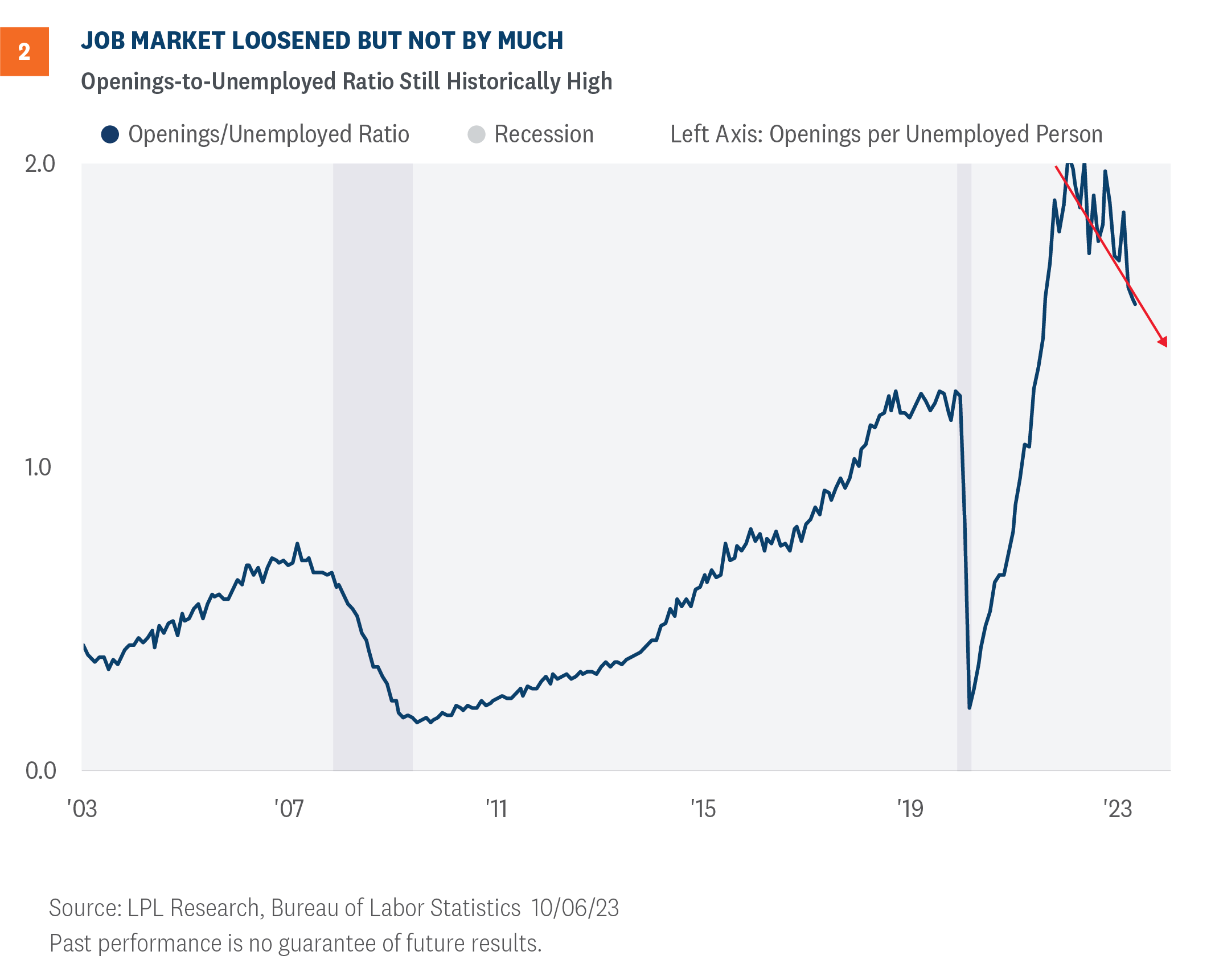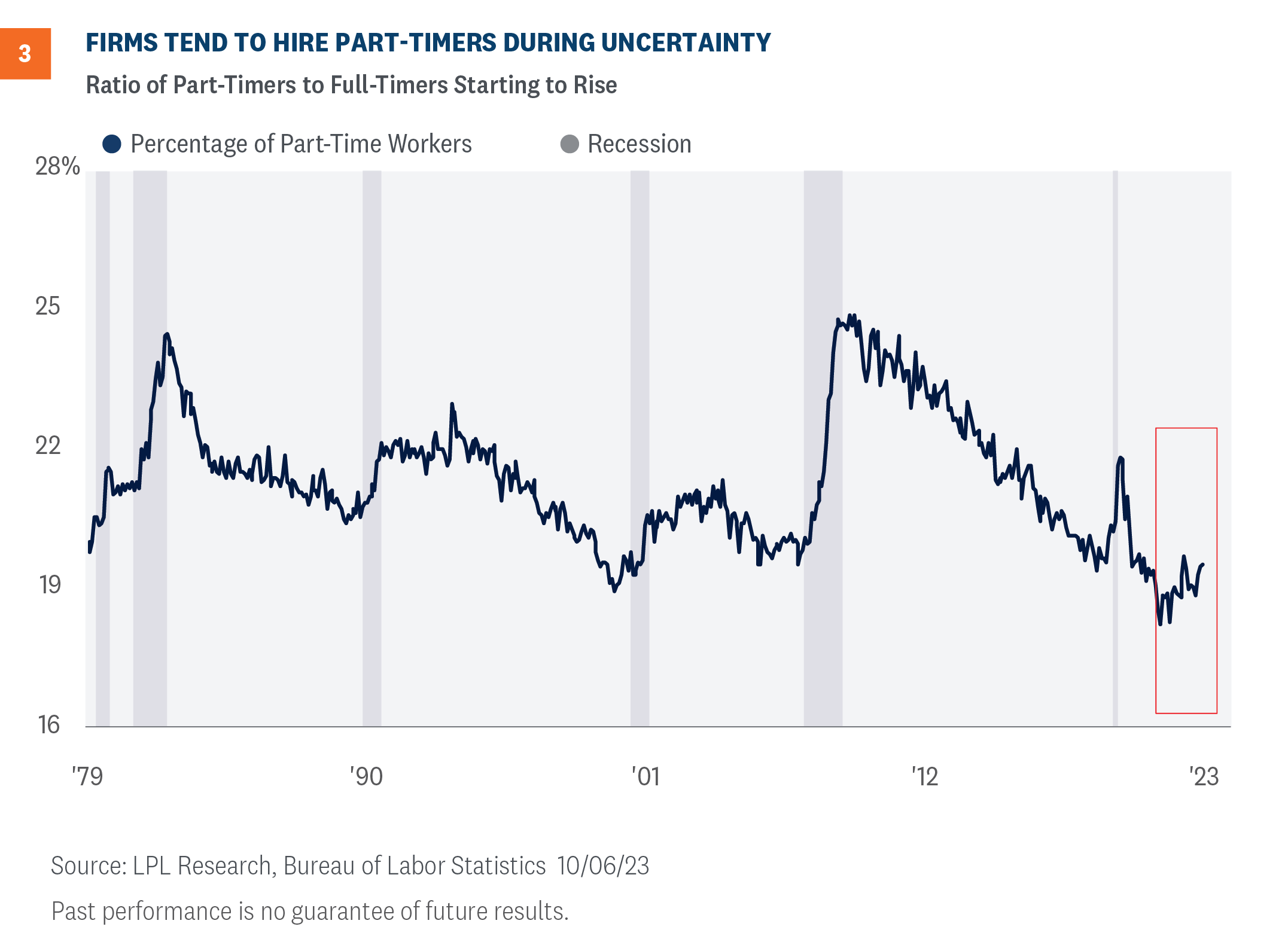
Economic Impact: Can Something Good Come from a Crisis?
By Mueller Financial Services, October 23, 2023
Despite headwinds, the U.S. could experience structural changes in the labor market, residential real estate, and inflation as the post-pandemic economy progresses into the New Year. As markets adjust to a new regime, investors should recognize the economy is becoming less interest rate sensitive and they should focus on leading indicators such as the ratio of part-time workers and not on lagging metrics such as the headline growth stats mostly cited in the media.
Setting Up for a ‘Eucatastrophe’
J.R.R. Tolkien, author of the Lord of the Rings and famous member of The Inklings at Oxford University during the 1940s, coined a word—eu·ca·tas·tro·phe—to describe an event that turns out surprisingly better than expected. Frodo’s defeat sets up for an unpredictably successful conclusion.
One could argue that the post-pandemic economy had a few moments when things turned out better than expected. The economy grew faster than expected in recent quarters, unemployment remained historically low, and some sectors such as homebuilders have boosted activity despite the macro headwinds. The tight labor market seems to be a boon for workers, and one could argue that workers have never been in a better position to bargain for better pay and more benefits, but more on that later in this piece.
As investors navigate the final quarter of the year, the Federal Reserve (Fed) has pushed the fed funds target rate up 5.25 percentage points to reach an upper bound of 5.50%. And as inflation pressures ease, the fed funds rate will essentially become more restrictive, enough for the Fed to pivot from a tightening bias to a more wait-and-see approach. The Federal Open Market Committee (FOMC) members are starting to view the risk of overtightening to be in balance with the risk of insufficient tightening. Inflation has become less sticky, especially as services inflation cools. The large rise in shelter costs was a key driver of headline inflation in recent months but its impact will likely wane in the near future. Rent prices are off their peak according to industry reports, and investors should know that there is a sizable lag in time between a reported movement in industry rental data and the official government metrics.
Core inflation excluding shelter is more benign. Clearly, the inflation experience on homeowners is quite different than the experience felt by renters. Looking ahead, investors should carefully watch commodity prices for insight on how the Fed will act in future meetings.
Recession or No Recession?
From an investment standpoint, the “recession call” may end up being irrelevant. A recession could still emerge as consumers buckle under debt burdens and use up their excess savings, but a Fed sensitive to risk management might provide the salve necessary for more risk appetite. Investing is a relative game, meaning the U.S. could experience the 3 Ds of an economic contraction—depth, diffusion, and duration—but at the same time, still outperform other markets and hence, still be an attractive option for investors looking for calculated risk.
A shallow recession would likely provide a “eucatastrophe” for the domestic markets, as a recession would bring the labor market into better balance and would increase the odds of the Fed cutting rates. History shows that markets tend to rally as the Fed moves away from a tightening bias.
What Will Investors Likely Confront Next Year?
First, investors will confront a Fed increasingly committed to the other part of their dual mandate—stable growth. As highlighted above, inflation will still hover above the 2% long-run target and remain a concern, but the Fed will be less laser focused because the trajectory is going in the right direction.
Investors will enter a new era for rates. If the economy slows as predicted, the Fed will likely start discussing plans to cut rates. But those cuts may not come until the second quarter of 2024 and the magnitude of cuts may not be anywhere near as aggressive as markets thought just a year ago. We could see the fed funds target rate approaching 4.50% by the end of 2024, thereby suppressing both mortgage rates and the 10-year Treasury yield.
The mantra of “higher for longer” indicates market expectations that the Fed will avoid the mistake it made in previous periods when the target range bumped down against the zero lower bound. When rates are that low, the Fed could feel restricted if a major financial crisis emerges and policy makers have one less tool at their disposal to create accommodative financial conditions. Despite the potential for a recession, the Fed will not be inclined to aggressively cut rates and should keep rates higher throughout the year.
Second, investors will confront a real estate market reeling from the unintended impacts of hybrid work and high borrowing costs. One unintended consequence of hybrid work is an economy less sensitive to interest rates. Historically, tighter monetary policy translates to higher mortgage rates, slowing the real estate market, and cooling house prices. In 2024, investors will still see a slower real estate market but not much normalization of home prices because of lean inventory and buyers coming to the closing table with cash. As households move from higher cost of living areas to lower, many with home equity use cash to purchase a new home, thereby skirting the credit markets. Perhaps we are in a new era for residential real estate.
Third, investors will confront a new era for the average worker. Some call this the democratization of the workforce since never before have workers had this much in their favor. As the American worker has had a few years to adjust to the hybrid work model, we should continue to see a fair amount of turnover. Some have seen the fastest way to higher pay is moving to a new job. As shown in Figure 1, the growth rate for job switchers has never been this wide. Of course, the hybrid model can only operate in some sectors.

Further, many regions of the U.S. have passed pay transparency laws that require firms to disclose the salary range for job openings. We expect firms to have relative difficulty in finding qualified workers and despite risks of an economic downturn, we do not expect a material rise in the unemployment rate. No doubt, this is a new era for many workers. To the relief of policy makers, labor markets are starting to come into balance but still, the demand for workers seems to be much stronger than the supply of workers (Figure 2).

Looking For A Leading Indicator?
The recent uptick in the number of part time workers implies that businesses are starting to feel the effects of economic uncertainty, even though many of the official metrics imply robust growth. For example, growth estimates for Q3 will be released October 26 and will likely be better than expected. However, investors should be especially careful with coming to strong conclusions by lagging indicators. Now more than ever it is important to focus on leading indicators that guide investors into wise decisions (Figure 3).

With a macro backdrop such as this, where could investors see a surprisingly favorable turn of events? A Fed entering a new era of policy, homebuilders able to capitalize on the unique macro environment, and workers in a historically strong position could all set up markets for a eucatastrophe.
Latest Thinking on Asset Allocation
LPL’s Strategic and Tactical Asset Allocation Committee (STAAC) recommends a neutral tactical allocation to equities, with a modest overweight to fixed income funded from cash. The risk-reward trade-off between stocks and bonds looks relatively balanced to us, with core bonds providing a yield advantage over cash. The STAAC recently recommended reducing allocations to developed international equities and increasing allocations to the U.S. A relatively better economic growth outlook in the U.S. as the Fed moves to a wait-and-see status and stickier inflation in Europe are the primary reasons for the change, while currency risk remains elevated. Keeping us at neutral, rather than negative, are attractive valuations and a still-bullish outlook for Japanese equities.
The STAAC recommends being neutral on style, favors large caps over small, and maintains energy and industrials as top sector picks.
Within fixed income, the STAAC recommends an up-in-quality approach with benchmark-level interest rate sensitivity. We think core bond sectors (U.S. Treasuries, agency mortgage-backed securities (MBS), and short-maturity investment grade corporates) are currently more attractive than plus sectors (high-yield bonds and non-U.S. sectors) with the exception of preferred securities, which look attractive after having sold off this spring due to stresses in the banking system.
Jeffrey Roach, PhD, Chief Economist
You may also be interested in:
- Earnings Hope to Keep This One-Year-Old Bull Market Going – October 16, 2023
- Yields Higher for Longer: Why We’re Updating Our Treasury Forecast – October 9, 2023
- Prospects for a Fourth Quarter Rally – October 2, 2023
IMPORTANT DISCLOSURES
This material is for general information only and is not intended to provide specific advice or recommendations for any individual. There is no assurance that the views or strategies discussed are suitable for all investors or will yield positive outcomes. Investing involves risks including possible loss of principal. Any economic forecasts set forth may not develop as predicted and are subject to change.
References to markets, asset classes, and sectors are generally regarding the corresponding market index. Indexes are unmanaged statistical composites and cannot be invested into directly. Index performance is not indicative of the performance of any investment and do not reflect fees, expenses, or sales charges. All performance referenced is historical and is no guarantee of future results.
Any company names noted herein are for educational purposes only and not an indication of trading intent or a solicitation of their products or services. LPL Financial doesn’t provide research on individual equities.
All information is believed to be from reliable sources; however, LPL Financial makes no representation as to its completeness or accuracy.
All investing involves risk, including possible loss of principal.
US Treasuries may be considered “safe haven” investments but do carry some degree of risk including interest rate, credit, and market risk. Bonds are subject to market and interest rate risk if sold prior to maturity. Bond values will decline as interest rates rise and bonds are subject to availability and change in price.
The Standard & Poor’s 500 Index (S&P500) is a capitalization-weighted index of 500 stocks designed to measure performance of the broad domestic economy through changes in the aggregate market value of 500 stocks representing all major industries.
The PE ratio (price-to-earnings ratio) is a measure of the price paid for a share relative to the annual net income or profit earned by the firm per share. It is a financial ratio used for valuation: a higher PE ratio means that investors are paying more for each unit of net income, so the stock is more expensive compared to one with lower PE ratio.
Earnings per share (EPS) is the portion of a company’s profit allocated to each outstanding share of common stock. EPS serves as an indicator of a company’s profitability. Earnings per share is generally considered to be the single most important variable in determining a share’s price. It is also a major component used to calculate the price-to-earnings valuation ratio.
All index data from Bloomberg.
For a list of descriptions of the indexes and economic terms referenced in this publication, please visit our website at lplresearch.com/definitions.
This research material has been prepared by LPL Financial LLC.
Securities and advisory services offered through LPL Financial (LPL), a registered investment advisor and broker -dealer (member FINRA/SIPC). Insurance products are offered through LPL or its licensed affiliates. To the extent you are receiving investment advice from a separately registered independent investment advisor that is not an LPL affiliate, please note LPL makes no representation with respect to such entity.
Not Insured by FDIC/NCUA or Any Other Government Agency | Not Bank/Credit Union Guaranteed | Not Bank/Credit Union Deposits or Obligations | May Lose Value |
RES-1658818-0923 | For Public Use | Tracking #494213 (Exp. 10/2024)
Related Insights

November 4, 2024
Election Stock Market Playbook
SharePrinter Friendly Version As Election Day approaches, we discuss potential stock market implications of various possible outcomes. But before we …
Read More navigate_next
October 28, 2024
What Scares Us About the Economy and Markets
SharePrinter Friendly Version Stocks have done so well this year that it’s fair to say market participants haven’t feared much. …
Read More navigate_next